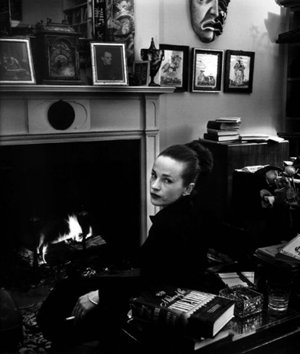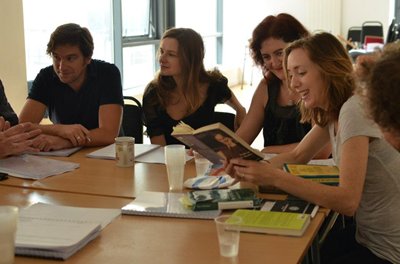The previews were packed out, the run has been extended until 20 October, and it seems that The Talk of The Town has become, well, the talk of the town. Produced by Hatch Theatre Company, Landmark Productions and Dublin Theatre Festival, the play was quite lovingly developed by director Annabelle Comyn, artistic director of Hatch, and award-winning author Emma Donoghue, over the long distance between Canada, where the Man Booker short-listed writer is based, and Dublin, where Comyn was fresh from a successful run of Tom Murphy’s The House in the Abbey Theatre.
Getting the two in the same place at the same time proved impossible, which is fair enough, and certainly true to the theme of the play’s process. Comyn was caught right before get-in and previews; Donoghue had a some free time the afternoon of opening night. In talking to both, it quickly became clear that they are very much on the same page, making it was easy to create a dialogue between the two, about the genesis of the project, their collaboration, and their approach to the life of Maeve — with some input from the woman herself.
 MAEVE BRENNAN: I think of New York as the capsized city. Half-capsized, anyway, with the inhabitants hanging on, most of them still able to laugh as they cling to the island that is their life’s predicament. (from the introduction to The Long-Winded Lady)
MAEVE BRENNAN: I think of New York as the capsized city. Half-capsized, anyway, with the inhabitants hanging on, most of them still able to laugh as they cling to the island that is their life’s predicament. (from the introduction to The Long-Winded Lady)
EMMA DONOGHUE Most of the play is her New York life at The New Yorker magazine between about 1949 and 1960.
ANNABELLE COMYN My first introduction to her writing was The Springs of Affection, her short stories. That came out as a special edition with the Irish Independent, in the mid 2000s. So there was an awareness of her work around then. I had received a Dublin City Council bursary to research Maeve, to see would a project be viable. I was discussing a different project with Loughlin Deegan [former Director of Dublin Theatre Festival]; I said that I was also developing on Maeve Brennan and he just went, ‘Ah, I adore Maeve Brennan.’ So he was immediately interested in that, and he suggested Emma, because he knew her, and her plays from the 1990s.
ED I’m surprised that they thought of me, because I haven’t had a big profile as an Irish playwright. The last big new play I did was for Magic Theatre in San Francisco in 2000, so I haven’t a full production of an Irish play since 1996. I’m thrilled they saw the potential.
It’s wonderful to get back into the theatre again. With fiction, you can write a piece of fiction and then send it out into the world and try to sell it, it doesn’t matter where you’re living at the time. Theatre tends to grow out of relationships, because it’s such a hands-on art. It’s so fortuitous that this happened to me.
AC We wanted to get the whole thing off the ground, so I flew out to Canada and met Emma, and spent five or six days working on what we thought a production about Maeve Brennan should be.
ED We spent three days, literally, reading Maeve Brennan together.
AC We did a lot of emailing. Huge, long emails… I’m much better on the phone. I was going round the houses trying to describe things in emails. So I said, do you mind if we just phone?
ED Annabelle and I had these long phone calls. I really should have bought a headset, I was keeping my phone between my ear and shoulder while I typed.
AC We’d talk for an hour and half, quite a bit. We talked things out.
 ED We also had two separate week-long workshops with actors. That was crucial — when you have workshops early enough, they give you the chance to explore things. You’re not just testing a script, you’re playing with ideas, and the actors brought a breadth of knowledge about the Ireland in the 20th century. They’d be sitting around going, ‘My grandmother would put it like this,’ ‘But my father used to do that.’ They weren’t just actors acting, they were giving feedback about everything in the play.
ED We also had two separate week-long workshops with actors. That was crucial — when you have workshops early enough, they give you the chance to explore things. You’re not just testing a script, you’re playing with ideas, and the actors brought a breadth of knowledge about the Ireland in the 20th century. They’d be sitting around going, ‘My grandmother would put it like this,’ ‘But my father used to do that.’ They weren’t just actors acting, they were giving feedback about everything in the play.
Even though the process was unusual for me, I would definitely want to do it again like this. I am convert to the idea to working with a director from the beginning.
AC (Maeve has) got great psychological insight, and her writing is pared back and succinct, and the simplicity of how things are written but with a huge amount of depth and understanding. The detail — it’s just immense in her work, yet the sentences never feel flabby or overburdened. It’s very similar to the work I like with playwrights that I did.
***
MAEVE BRENNAN: Home is a place in the mind. When it is empty, it frets. It is fretful with memory, faces and places and times gone by. Beloved images rise up in disobedience and make a mirror for emptiness. Then what resentful wonder, and what half-aimless seeking. It is a silly state of affairs. It is a silly creature that tries to get a smile from even the most familiar and loving shadow. Comical and hopeless, the long gaze back is always turned inward. (The Visitor)
AC She was very social, she hung around with the literati, she dated lots of men from The New Yorker, lived the high life, really, with a huge amount of alcohol as well, smoking constantly, crazy hours… (The show looks at) how that reconciled with the stories that she wrote. They’re worlds apart.
ED I think that one of the reasons they picked me to write the play is that I am an emigrant, an Irish woman who moved. And I can completely see why you would move. In every era there are good reasons to get the hell out of Ireland. We wanted the play to be very much about that, but not to be heavy handed.
Annabelle kept saying to me, any time we had a piece where Maeve Brennan seemed to be analyzing herself, she’d say, ‘Cut that, she was living too fast, she was not stopping to analyse that stuff.’ So a lot of the pain of emigration is implied literally by the gap onstage between the Irish scenes and the American ones. You can sense the pain of that loss: she’d go to a glamourous party and then she’ go back to the office and try and remember exactly what the house in Ranelagh was like.
AC Every story set in Ireland has the detail of that house, and you feel like you know it intimately. Her image and her memory of it makes it another persona in her stories. You’ve got a whole world in one suburban house.
ED The play uses bits of 1920s Ireland from her stories, but really very small bits, so you get the feeling of her being haunted by the Ireland she came from and trying to write about it, it was a total contrast with the life she was living.
AC In her letters and her short stories, she was always interested in who we were, and who we are now. She describes that in terms of ‘held moments’, or fragments of time that have disappeared. What was that fragment of time? It seems like that fragment is what connects the past and the present, and the totally different worlds of Maeve — the Maeve that she writes about in her fiction, of Ireland predominately, and the Maeve living in New York.
ED Instead of any overt commentary on the difference between the two lives, sometimes you just literally see her against the backdrop of what she was writing about, little echoes, but mostly yawning gaps between, for instance, the wife and mammy trapped in the home role of the women in her stories, and then Maeve herself who didn’t go there, who would never do the washing up.
AC I think there was a letter from a friend of hers — she had studied to be a librarian, and the friend said basically, ‘Don’t come back. There’d be nothing for you here.’
***
MAEVE BRENNAN: When the hauteur slipped from her face, what would I see? Despair, I imagine. Not the passive, withdrawn despair that keeps itself in silence but the raging kind that incinerates all before it. ('They Were Both about Forty', The New Yorker, 28 September, 1968)
AC It’s fundamentally a play about being a writer.
ED I don’t usually write about writers, I can’t stand people whose novels are about novelists like themselves. But here, for the first time, I got to indulge my own fascination with writing and the writing process. What makes Maeve an interesting writer is she’s the neurotic kind, not the sensible sort of writer like me — you’d never write about me: gets up in the morning, sends the kids off the school, sits down to her laptop, answers emails. Whereas with Maeve Brennan, I can’t imagine her ever answering emails!
We tried to show, in a ten-year slot, both her best times and her worst times, and at least gesture towards her decline. We show her going through one breakdown and her marriage ending. Even though by the end of the play, she’s got through that and survived, she’s writing again, she’s back on track, you know that her life will continue to be a mess.
AC A niece of hers described that she was too hard on herself, always worrying about unresolved things, or trying to explore ideas and feeling that she can’t get to the heart of it. You see it in her letters to her editor, gnawing at things.
ED The main thing I chose to focus on was the fact that in one of her short stories, Maxwell and Shawn wanted her to cut out five pages. It was after a period of writer’s block, and she’s finally managed to produce a story and they want her to cut it, and she refused. I decided to make this the dramatic heart of the play in terms of her writing. Years went by — they fought about that story for years on end. It was so important to her, she wouldn’t publish it with the cuts that he wanted.
Different times, eh? It’s not just that they’re constantly smoking and drinking, but that they could have five years writer’s block and yet not get sacked!
AC Not only was it a fantastic opportunity to explore Maeve’s work again, and to look at who she was, I think it’s also a reevaluating of a great Irish woman writer, and to value what that means, and what she was writing about. Also, we can explore our own lives and where we’re at.
ED And it was quite fun to write something that makes journalism seem glamorous!
Susan Conley is a cultural critic and author.